As a homeowner, knowing the ultimate checklist for asbestos removal is essential. Start with an extensive inspection to identify asbestos-containing materials and assess their condition. Prepare the work area by sealing it off and confirming equipment like HEPA vacuums is ready. Use safe removal techniques, including wetting materials to minimize fiber release. Always wear proper personal protective equipment (PPE) and establish a decontamination area post-removal. Conduct thorough inspections and air sampling to verify the area is safe before reoccupying. Finally, make certain all documentation meets regulatory standards to protect your property and health. There's more to uncover about guaranteeing safety throughout this process.
Initial Inspection Process
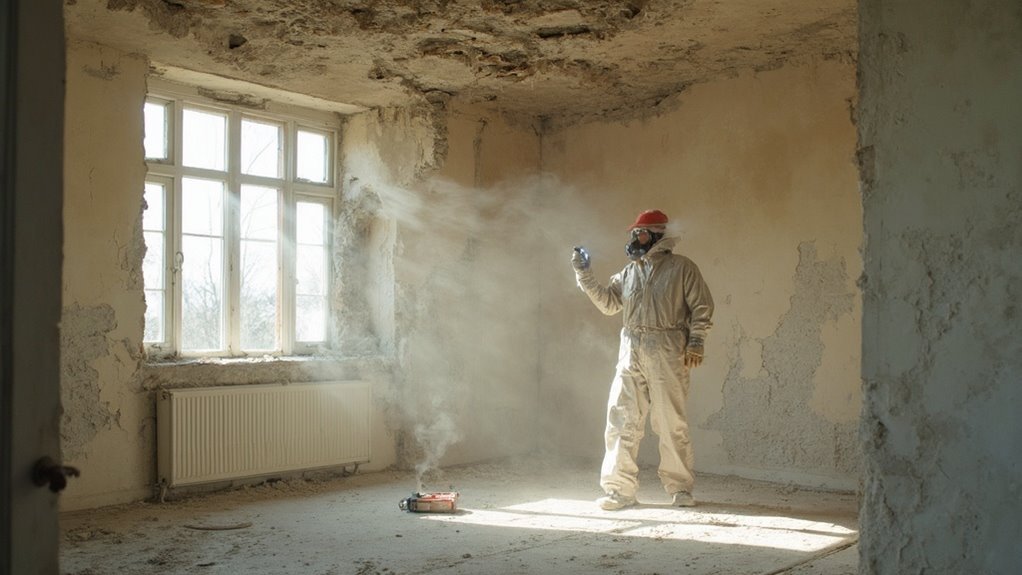
The initial inspection process for asbestos removal involves several critical steps to guarantee safety and compliance. First, professionals conduct a historical analysis of the property, gathering information through interviews and records. This background helps identify potential asbestos-containing materials, especially in buildings constructed before the 1980s.
Next, accessible areas undergo thorough inspection techniques to identify common asbestos locations, such as insulation and ceiling tiles. Inspectors assess the condition of suspected materials, looking for signs of degradation or damage, which indicates potential risk. They document all findings meticulously for future reference and risk assessment, noting environmental factors that might influence asbestos disturbance. Additionally, asbestos exposure is linked to severe health risks, making identification crucial.
Sampling and testing procedures follow, where certified professionals collect samples of suspected materials, adhering to strict safety protocols to prevent fiber release. They send these samples to accredited laboratories for analysis, often using advanced methods like Transmission Electron Microscopy (TEM) on air samples. Notably, asbestos inspection is essential for ensuring that any hidden or undetected materials are identified before removal begins.
Pre-inspection preparations include turning off HVAC systems to minimize airflow, and professionals take care to contain the sampling area, ensuring only trained individuals handle asbestos. This thorough process lays the groundwork for safe and effective asbestos removal.
Risk Assessment Guidelines
When evaluating asbestos risks, start by identifying the sources of asbestos within the building, noting the specific types present. Next, review the condition of these materials, focusing on any damage or deterioration that could increase the risk of fiber release. This thorough examination is essential for determining appropriate safety measures and necessary remediation actions. Additionally, it is crucial to understand that even non-friable asbestos can become hazardous if deteriorated or disturbed.
Identifying Asbestos Sources
Identifying potential asbestos sources in a building is crucial to guaranteeing safety during renovation or demolition. You must be proactive in evaluating the risk by following a structured approach. Here's a checklist to guide your identification process:
- Survey and Analysis: Conduct a thorough survey and analyze samples to determine the presence and condition of asbestos.
- Visual Inspection: Perform a visual inspection of the site, focusing on common areas where asbestos may lurk.
- Document Review: Review any available building documentation, including previous asbestos surveys and reports.
- Certified Inspectors: Confirm inspections are carried out by certified inspectors familiar with asbestos testing methods and asbestos risk factors.
Evaluating Material Condition
Evaluating the condition of asbestos-containing materials (ACMs) is imperative for guaranteeing safety during any renovation or demolition project. Start by determining whether the ACMs are damaged or disturbed, since this directly impacts their safety. Pay close attention to material deterioration and ascertain if the asbestos is friable, which means it can easily crumble and release fibers into the air. This is critical for your exposure evaluation.
Next, evaluate the likelihood of fiber release during the work. If the ACMs are in poor condition or will be disturbed, the risk increases considerably. You should additionally assess the potential for exposure to asbestos fibers, which can have severe health implications.
After identifying the risk levels, it's fundamental to implement control measures to minimize exposure. This may include using personal protective equipment (PPE) like masks and gloves, in addition to establishing decontamination procedures. Document your findings in a risk assessment report, and guarantee this information is shared with workers and stakeholders. Regularly review and update the assessment to maintain compliance with regulations and guarantee ongoing safety throughout the project.
Preparing the Work Area
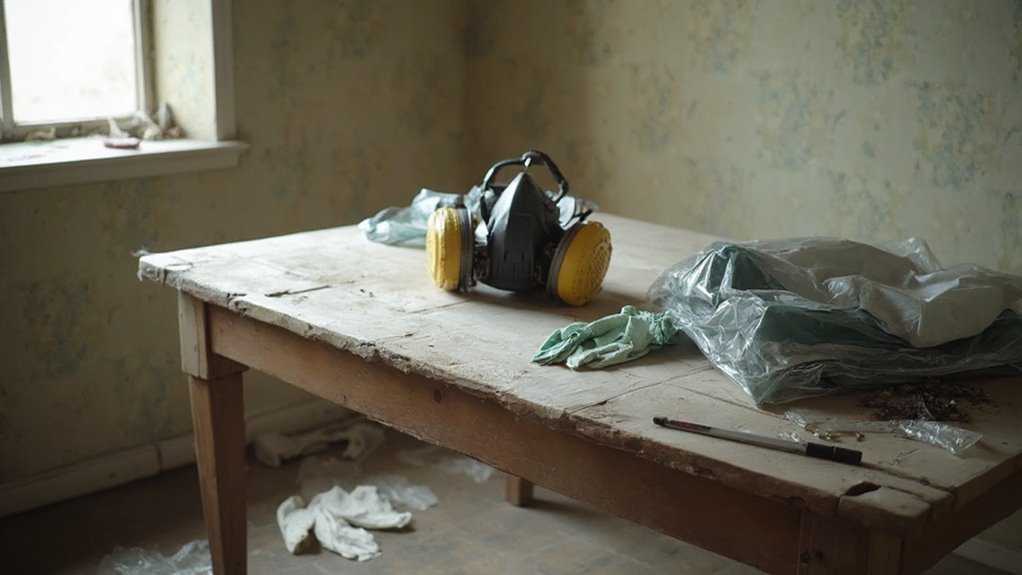
Preparing the work area for asbestos removal involves several critical steps to confirm safety and compliance. Proper work area preparation is crucial to minimize risks and guarantee effective cleaning protocols.
- Clean all surfaces: Use HEPA-filter equipped vacuums and wet wiping methods to avoid airborne fibers. Never use a broom to dry sweep, as this can stir up dangerous particles.
- Establish containment: Use clear poly sheeting to create non-porous barriers around the work area. Secure these barriers with Raptor Grip Poly Tape to maintain isolation.
- Turn off HVAC systems: This prevents the circulation of asbestos fibers throughout your home. Confirm all vents are sealed temporarily.
- Remove personal items: Clear the work area of all furniture and belongings to protect them and reduce contamination risks.
Safe Removal Techniques
Effective asbestos removal techniques are important for guaranteeing safety and minimizing exposure to harmful fibers. To achieve this, the Wet Removal Method is highly recommended since it keeps materials moist, greatly reducing fiber release during the process. Controlled Dismantling is another effective approach, allowing you to carefully disassemble materials without disturbing asbestos fibers.
When dealing with non-friable asbestos, it's necessary to keep the materials intact and adequately wet. Sealed enclosures play a key role in preventing fiber escape by creating an airtight environment. Utilize specialized tools, such as glove bags and hand tools, for handling more fragile materials safely.
Incorporate physical barriers like plastic sheeting to establish a sealed area and utilize negative air pressure systems to capture and filter any released fibers. Regular inspections verify the integrity of your containment measures, while portable airlocks further secure the workspace.
Personal Protective Equipment
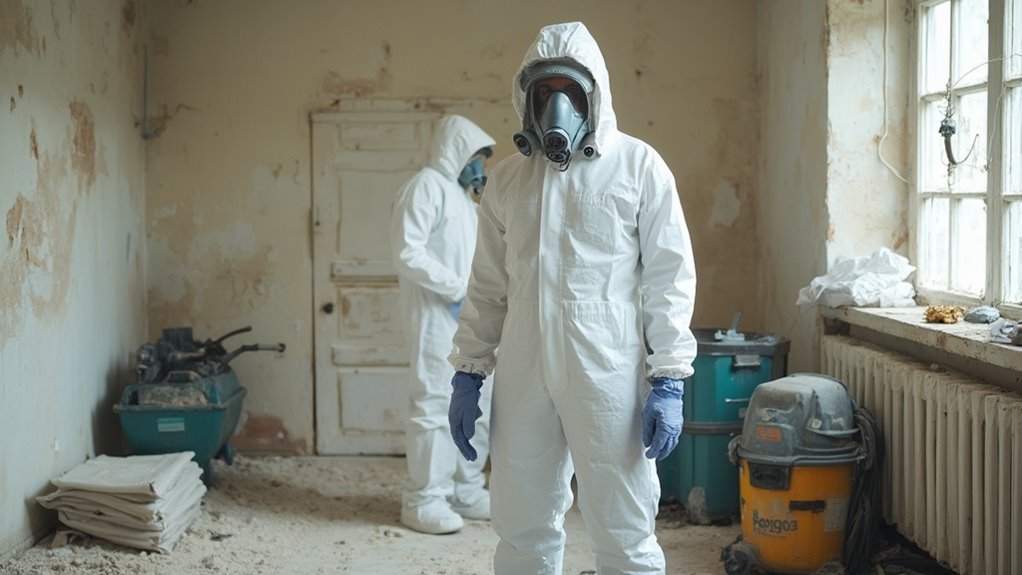
When handling asbestos, using the right personal protective equipment (PPE) is vital to guarantee your safety. You'll need to understand the fundamental types of PPE, adhere to proper usage guidelines, and follow strict decontamination procedures after the job. By doing so, you minimize the risk of asbestos exposure and contamination.
Essential PPE Types
As you commence asbestos removal, verifying you have the right personal protective equipment (PPE) is crucial for your safety. Adhering to PPE regulations and safety standards will protect you from harmful exposure. Here are the critical types of PPE you need:
- Respiratory Protection: Use a half-face respirator rated for asbestos work with HEPA-filtered cartridges. Opt for full-face respirators with P3 filters for maximum safety.
- Body and Skin Protection: Wear disposable coveralls made from dense, synthetic fabric. Don't forget disposable gloves, rubber boots, and hats to prevent fiber entry.
- Eye Protection: Invest in goggles or safety glasses with side protection to keep your eyes safe from asbestos fibers. Face shields can offer additional protection.
- Additional Equipment: Include HEPA-filtered vacuums for cleanup, wetting agents to suppress dust, and decontamination equipment to verify your work area is safe.
Proper Usage Guidelines
To guarantee your safety during asbestos removal, adhering to proper usage guidelines for personal protective equipment (PPE) is critical. Start with respirator selection: choose a half-face filter respirator equipped with a class P1 or P2 filter cartridge, or opt for a class P1 or P2 disposable respirator specifically designed for asbestos work. Verify your respirator complies with Australian Standard AS1716 or relevant international standards. If you have facial hair, it's important to avoid it, as it can compromise the seal; consider a fully hooded respirator instead. Always follow the manufacturer's fitting instructions for an airtight fit.
For wearing PPE, use disposable coveralls with hoods and foot sections to prevent fiber contamination, and wear disposable gloves and rubber boots to avoid skin contact. After your work, seal all contaminated PPE in asbestos waste bags for proper disposal. PPE maintenance is imperative; inspect your equipment before use to confirm it's in good condition. Additionally, verify you have an emergency plan in case any PPE becomes damaged during the job. Training on PPE usage and fitting techniques is important for all involved in the removal process.
#
Decontamination Procedures
Decontamination procedures for personal protective equipment (PPE) are vital to guarantee your safety and prevent the spread of asbestos fibers. Properly implementing decontamination methods guarantees that you minimize exposure and protect others. Follow these fundamental PPE requirements during decontamination:
- Use a Wet Method: Apply a water mist to lock down loose fibers on your clothing and equipment.
- Utilize a HEPA Vacuum: Gently vacuum any remaining asbestos fibers from your gear.
- Re-Suit When Necessary: Always put on a new disposable suit over contaminated clothing before starting decontamination.
- Dispose Properly: Seal contaminated clothing and tools in asbestos waste disposal bags for safe removal.
Establish a designated decontamination area away from unprotected individuals, guaranteeing it's isolated and has a water source. Wear appropriate PPE, including respirators, disposable coveralls, gloves, and safety goggles. After decontamination, shower thoroughly, wash your hair, and clean the respirator. By adhering to these decontamination procedures, you safeguard your health and the wellbeing of those around you. Remember, safety first!
## Decontamination Procedures
Effective decontamination procedures are fundamental for ensuring safety when working in areas with asbestos. Establish designated decontamination zones to separate clean and dirty areas, preventing cross-contamination. Begin by removing outer protective clothing in the dirty zone, rolling it inside out, and placing it in approved disposal bags.
Once your clothing is disposed of, thoroughly shower to eliminate any remaining asbestos fibers from your skin and hair before entering the clean zone. It's imperative to put on clean clothing only in this designated area. For respirators, store them in plastic bags for proper cleaning.
When it comes to equipment cleaning, all tools used in asbestos removal must be decontaminated after use. Utilize wet wiping and HEPA vacuuming methods to effectively remove asbestos dust from equipment. Clean these tools in a designated area to avoid spreading contaminants. Remember, specialized equipment such as HEPA vacuums is critical for effective decontamination.
Post-Removal Inspections
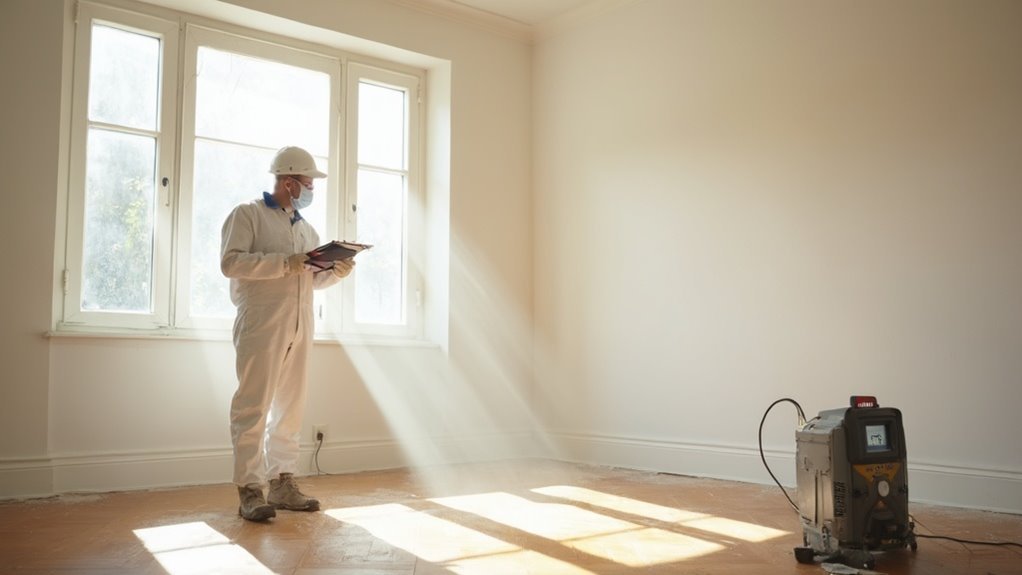
Post-removal inspections are vital for confirming that all asbestos has been safely removed and that the area is safe for reoccupation. These inspections guarantee compliance with clearance criteria, providing you peace of mind. Here's what you can expect during the post-removal inspection process:
- Technical Clearance Testing: Air sampling and laboratory analysis will verify that fiber levels are below the legal limit of 0.01 fibers per milliliter of air.
- Continuous Monitoring: Specialized equipment measures airborne asbestos concentrations to guarantee worker safety during and after the removal.
- Visual Inspections: Inspectors will conduct thorough site inspections to confirm the removal of all asbestos-containing materials and that the area is free of residue.
- Documentation: Detailed inspection reports and clearance certificates will be issued, maintaining records for regulatory compliance and future reference.
Through meticulous post-removal testing, you can trust that the space is safe for reoccupation. Meeting clearance criteria isn't just a legal requirement; it's vital for your health and safety. Don't take shortcuts—guarantee thorough inspections are conducted before returning to your home.
Waste Management Practices
Proper waste management practices are crucial when dealing with asbestos removal to guarantee safety and compliance with regulations. Start by implementing effective waste segregation practices. Identify and separate asbestos-containing materials (ACMs) from non-hazardous waste to prevent cross-contamination. Wet ACMs during removal to minimize asbestos emissions and package them in leak-tight containers. Remember to seal and label these containers clearly with the generator's name and waste location.
Follow strict waste disposal regulations by using double-bagging techniques and airtight containers for transport. Confirm that all asbestos waste is disposed of in specialized landfills equipped to handle such materials. It's critical to notify the appropriate government agencies beforehand and provide a 24-hour notice before disposal. Maintain meticulous waste shipment records that detail the waste's source and disposal site.
Train personnel thoroughly to handle the materials safely, and establish emergency procedures for any accidental spills. After disposal, cover the waste with at least 15 cm of non-asbestos material within 24 hours to prevent exposure. Adopting these practices will help you manage asbestos waste responsibly and protect both human health and the environment.
Documentation and Compliance
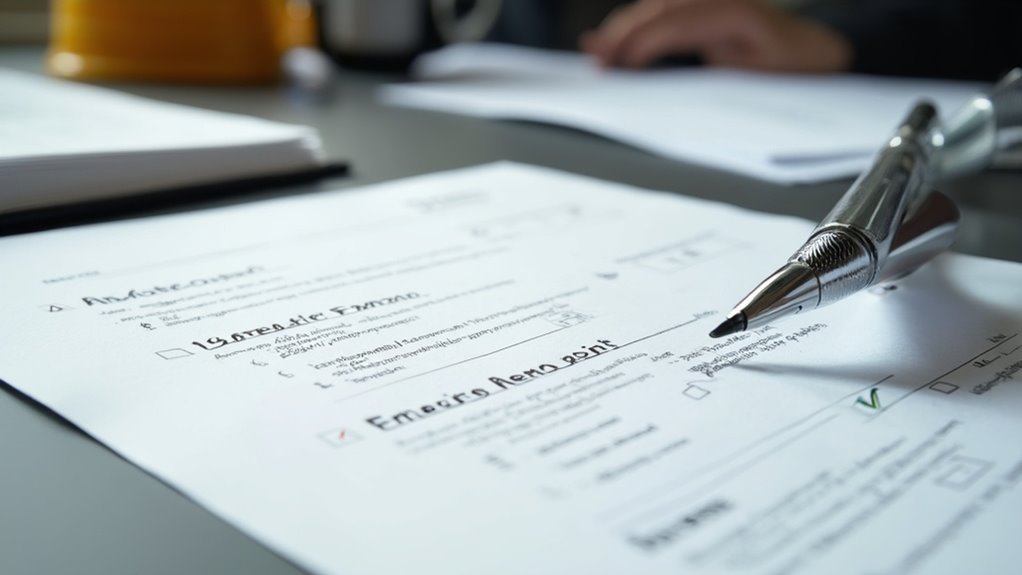
When managing asbestos removal, thorough documentation and compliance with relevant regulations are crucial to guaranteeing safety and legal adherence. Proper documentation management not only keeps you compliant but likewise protects your health and property. Here are four key compliance strategies to follow:
- Complete an Asbestos Survey: Submit it to your local government for permits.
- Maintain On-Site Documentation: Keep all relevant documents, including asbestos notifications, readily available at the construction site.
- Hire Certified Professionals: Verify that your contractors are accredited and meet EPA standards.
- Follow State and Local Regulations: Abide by specific rules applicable to your area, like New York's Industrial Code Rule 56-11.5.
Frequently Asked Questions
How Much Does Professional Asbestos Removal Cost?
Professional asbestos removal costs between $7,500 and $22,500, influenced by cost factors like material type, area, and disposal. You can additionally consider removal options like encapsulation, which may reduce overall expenses considerably.
Can I Remove Asbestos Myself?
Over 70% of homes built before 1980 contain asbestos. While DIY asbestos removal might seem tempting, improper identification techniques and safety measures can lead to serious health risks. It's best to hire certified professionals for safety.
What Are the Health Risks of Asbestos Exposure?
Asbestos exposure can lead to serious long-term effects, including lung cancer and asbestosis. You might not notice asbestos symptoms until years later, underscoring the importance of avoiding exposure whenever possible to protect your health.
How Long Does the Asbestos Removal Process Take?
The asbestos removal timeline varies based on factors like material type, area size, and safety protocols. Thorough asbestos testing is crucial to determine scope, ensuring a safe and efficient process for your specific situation.
What Should I Do if I Find Asbestos?
Finding asbestos is like uncovering a ticking time bomb; act immediately. Schedule asbestos testing with a certified inspector, and guarantee safe disposal by hiring licensed professionals to handle removal and prevent contamination in your home.
